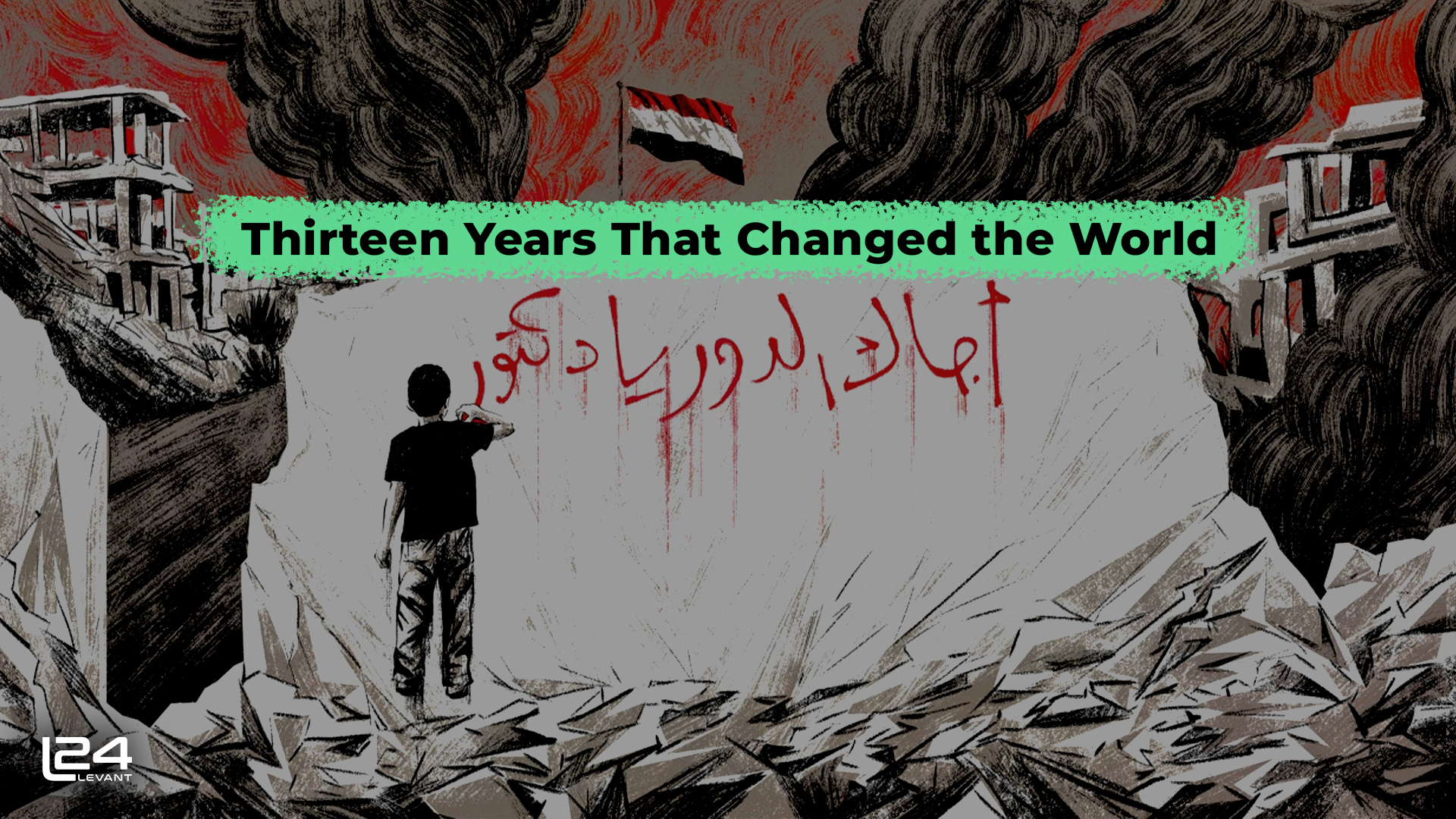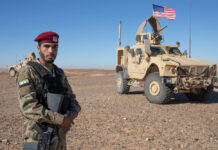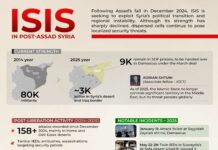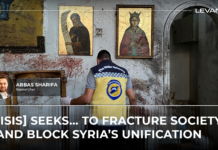A Lasting Legacy for Good or Ill

Writer: Abdullah Ahmad
Thirteen years ago, a spark ignited in Syria, setting off a revolution that would reverberate across the globe. From the rise and fall of terror groups to the intervention of world powers, the Syrian conflict has reshaped geopolitics and altered the course of history. As we commemorate this anniversary, Levant 24 reflects on some of the most pivotal moments that have defined the Syrian Revolution and its impact on the world stage.
Thirteen years ago, on March 18th, a pivotal moment unfolded in Daraa, Syria, when protests erupted calling for the release of schoolboys who had been detained, along with demands for an end to corruption and greater political freedoms. Assad regime security forces brutally quashed the demonstrations by firing live ammunition, murdering three, with a fourth tragically succumbing to their injuries the subsequent day.
This violent crackdown on peaceful protests served as a catalyst that would set into motion a chain of events that would forever change Syria and the world. The eventual murder under torture of these schoolboys, coupled with the lethal suppression of dissent, marked a turning point in Syria’s trajectory shaping the course of events for years to come.
The Syria Playbook: Redefining Warfare
Russia’s entry into the Syrian conflict in 2015 bolstered the Assad regime, prolonging the war and shifting the balance of power in the region. Prior to Putin’s intervention, Assad was on the verge of losing all of Aleppo and revolutionary forces were making gains near the capital Damascus, yet more than simply providing a lifeline to Bashar, Russia’s role in Syria had a far greater impact.
It was in Syria that Russia would not only test over 300 different weapons on the cities and civilians of Syria but would develop tactics and strategies that would later be utilized in other theaters of war such as Ukraine by Putin and Gaza by Israeli forces. The brutal and often illegal strategies with no regard for human life, the norms of conventional war or international law, would collectively come to be known as the “Syria Playbook” as mentioned in a 2022 article for the Guardian.
The Syrian playbook is characterized by sieges, weaponization of aid, indiscriminate targeting of civilians and vital infrastructure, and the use of “humanitarian corridors” and “safe zones” as means of corralling populations for subsequent attacks. All went largely ignored in Syria thus setting a dangerous precedent for the future of warfare. The same siege tactics employed by Russian and Syrian forces causing the fall of Aleppo are mirrored in inhumane assaults on cities like Mariupol and Gaza. Civilians in both conflicts are held hostage, and barred from leaving as vital infrastructure such as homes, hospitals, schools, and power and water plants are systematically targeted and destroyed.
Russia, and Israel in its wake, have cynically transformed civilian spaces into military targets, disregarding the laws of war and the sanctity of human life. Hospitals, schools, markets, and bread and aid queues have means of spreading terror and suffering.

The tactic of announcing humanitarian corridors, and safe zones as seen in Ukraine and Gaza, bottling the population into small spaces, has left civilians in both countries vulnerable to relentless bombardment as such deals are consistently violated. The opening of such corridors often precedes intensified attacks, leaving civilians with a brutal choice: flee and risk death or remain and face annihilation.
The Kremlin and Tel Aviv have deployed disinformation, a hallmark of Russia’s strategy in Syria, with equal vigor in current conflicts. Denials of civilian casualties and war crimes, coupled with attempts to discredit independent reporting, and assassination of media personnel serve to obfuscate Russia’s culpability and sow confusion among the international community.
All of the horrors occurring in Gaza today, from leveling hospitals, and residential buildings, to siege and starvation, have all played out in Syria over the last 13 years. They were tested in Syria by Russia and “approved” by international inactivity, which has led to their use in contemporary conflicts not only by Russia but by other nations as well. Without substantive push-back, it is likely to be as ubiquitous in wars to come as tanks and planes – and it was born out of the atrocities committed against the Syrian people.
Turkey: Reexamining Allies and Interests
While Russia’s intervention shaped the horrific future of warfare, the entry of Turkey changed the political landscape in unforeseen ways. Turkey’s involvement in Syria, from hosting refugees to military operations against terror groups, has had far-reaching consequences. The establishment of “safe” and “de-escalation” zones and support for opposition factions over time have reshaped the dynamics of the conflict.
Turkey’s intervention in Syria has had profound implications for its relations with the US and its broader foreign policy posture. At the heart of the matter is Washington’s support for the Syrian Democratic Forces (SDF) which maintains operational ties to the PKK, a terrorist group long at war with Turkey. The groups have carried out attacks on Turkish troops both in Syria and across the border in Turkey during the 13-year-long conflict and have strained Turkish ties with Washington.
The failure of the US to abandon its support has led to Turkey and Russia strengthening ties and caused friction that has been the cause of the US refusal to sell Turkey various weapons systems and components and led to its purchase of Russian S-400s and expulsion from the F35 program, as well as Turkey’s obstruction of Sweden to NATO. This strategic realignment with Russia in Syria aims to challenge US influence in the region while advancing Turkey’s objectives of weakening the burgeoning PKK-dominated statelet incubating on its southern border.

In terms of Europe, Turkey’s involvement in Syria has also positioned it as a key player in managing the refugee crisis, thereby exerting leverage over its relations with the EU. The influx of Syrian refugees into Turkey has been a pressing issue, shaping Ankara’s policies towards both Syria and the EU. Turkey has sought to assert its influence in negotiations with the EU, further enhancing its geopolitical standing through the use of the “refugee card.”
Beyond its immediate implications for Turkey, the Syrian crisis has sparked a broader power struggle among regional actors, reshaping the strategic landscape of the Middle East. The conflict has divided the international community into opposing camps, with Turkey aligning itself with Western and Arab allies in support of revolutionary forces seeking regime change. While Iran, Russia, and China continue to back the Assad regime, reflecting competing visions for the future regional architecture.
Before the revolution, Turkey seemed set to be a long-term US partner, a NATO member with eyes on EU membership, and a defender of the status quo regarding Russia, Iran, and other outliers. However, over the 13 years of conflict, Turkey has had to stand against former partners and become more aggressive in putting domestic interests over international conventions. The Syrian conflict has led to drastic realignment of interests in the region leading to Turkey strengthening diplomatic ties with states like Russia while weakening former bonds with long-standing allies like the US.
Iran’s Entrenchment: The 35th Province
In February of 2013, Mehdi Taeb a confidant of Iran’s Supreme Leader said that Syria was Iran’s 35th province and “if we lose Syria, we won’t be able to hold Tehran.” Understanding the importance which the Iranian regime places on Syria it’s clear to see why they have continued to invest so much into maintaining Assad over the last 13 years.
Iran’s expansionist ambitions in Syria, manifested through military support and economic investments, have reshaped the country’s political and demographic landscape. Through a network of militias and deep ties to the Assad regime, Iran has entrenched its influence in Syria’s affairs.
Iran’s multifaceted involvement in the Syrian conflict has been characterized by extensive military, financial, and proxy support for the Assad regime, marking a strategic shift with profound implications for the region and beyond. Tehran’s military assistance, including the deployment of Revolutionary Guard forces and support for Shiite militias, has not only sustained the Assad’s government but also transformed the conflict dynamics. The reorganization of armed groups under Iran’s guidance, such as the National Defense Forces (NDF), has bolstered the regime’s military capabilities, rivaling the Syrian Arab Army (SAA) and enhancing Iran’s influence on the ground.

Moreover, Iran’s proxy warfare strategy, epitomized by its backing of Hezbollah, has played a pivotal role in supporting the Assad regime while allowing Tehran to maintain plausible deniability. By mobilizing Shiite militias as a transnational network, Iran has expanded its “Foreign Legion,” extending its influence across the region. This strategy not only serves Iran’s immediate objectives in Syria but also reinforces its broader geopolitical goals, shaping regional power dynamics and challenging adversaries.
The sectarian dimension of Iran’s involvement cannot be overlooked, as Tehran seeks to protect and expand its influence among Shiite communities in Syria and beyond. Iran’s support for the Assad regime has intensified sectarian polarization in the Middle East, rallying Shiite populations to its side while fueling Sunni fears of Iranian hegemony.
Furthermore, Iran’s strategic projection in Syria has far-reaching implications for regional security and international stability. Tehran’s foothold in Syria presents opportunities for force projection in the Eastern Mediterranean, potentially challenging Israel’s coastal infrastructure and NATO’s missile defense. The establishment of new fronts against Israel in the Syrian Golan Heights and along the Jordanian border demonstrates Iran’s intentions to destabilize key allies and expand its influence.
Overall, Iran’s role in the Syrian conflict goes beyond mere support for the Assad regime; it represents a strategic endeavor to reshape regional power dynamics and assert Tehran’s influence on the global stage. By leveraging military, financial, and proxy resources, Iran has entrenched itself in Syria, intensifying sectarian tensions, forging alliances, and challenging adversaries.
Birth of ISIS: Unleashing Terror
The Tigris and Euphrates rivers, which pass through both Syria and Iraq have long been associated with being vital to the birth of many civilizations helping to create a region with a rich history known as the fertile crescent giving rise to many empires. It is ironic that in 2013 the same regions of Iraq and Syria would birth one of the greatest scourges to contemporary civilization in the terror group dubbing itself the Islamic State of Iraq and Syria (ISIS).
The rise of ISIS marked a turning point in the Syrian conflict. As the group seized territory and spread fear as it rampaged across two countries, its influence extended far beyond the confines of borders, posing a threat to global security and stability. Perhaps one of the greatest assets to Assad, after Russia, was the emergence of ISIS. Not only did the group carve a bloody swath through the ranks of the revolution targeting civilians, and both Islamic and more secular components of the anti-Assad revolutionary forces, but it provided Assad a highly visible justification for his claims of “combating ‘terrorism’” and a smoke screen for Russia’s attacks on anti-Assad forces under claims of countering the group.

While the organization’s leadership and members in Syria have mostly been scattered or killed and many of its soldiers imprisoned, it is still active in small pockets of the eastern deserts of Assad-controlled areas of the country. The vast territories ISIS held in Iraq and Syria have vanished but the group’s treacherous years in Syria have left devastating scars on both the Syrian people and the revolution, wounds which have yet to completely heal. The group that was born out of the turmoil of the Syrian revolution, one of the most devastating terror groups in history, still holds pockets of loyalists carrying its banner in various regions around the world and its warped ideology is likely to persist for many more years to come.
Birth of a Narco-State: The Captagon Trade
Similar to the toxic ideology espoused by ISIS, akin to a venom infecting societies and exported abroad, another insidious threat emerged from within Assad-controlled Syria – the proliferation of Captagon, a potent amphetamine, has fueled the rise of a nascent narco-state in Assad-controlled Syria. Iranian-backed drug cartels, in collusion with the Assad regime, have exploited this trade to fund their operations and extend their influence. The emergence of the Captagon industry and the establishment of regime areas as a narco-state have reverberated far beyond the borders of Syria, profoundly impacting international politics, regional security, and Western countries, particularly Europe.
Assad’s Captagon trade has reshaped Middle Eastern geopolitics, influencing the policies of neighboring countries like Jordan and Saudi Arabia. Jordan, once a transit point for Captagon en route to the Gulf, now faces escalating tensions with Syria due to increased drug seizures along the border. Direct military actions against drug traffickers, including airstrikes in southern Syria, show the severity of the issue. In contrast, Saudi Arabia has tried to use Captagon as a bargaining chip to improve relations with the Assad regime, leveraging the drug trade in diplomatic negotiations.

The impact of Captagon extends beyond solely regional dynamics, affecting international relations with Western countries. The US and the EU have implemented sanctions targeting individuals and entities involved in the drug trade, including members of the Assad regime. However, despite these measures, Captagon continues to permeate global markets, with Europe emerging as a key transit point and destination market. Italian authorities seized a significant quantity of Captagon pills worth billions of euros, highlighting the scale of the challenge facing law enforcement agencies.
The nexus between the conflict borderland of Syria and Jordan and the illegal drug trade poses significant implications for regional security. The presence of militant groups involved in the Captagon trade further complicates the security landscape. Moreover, Captagon trafficking extends beyond the Middle East, with interceptions of shipments in Greece, Italy, Malaysia, and Libya indicating its global reach. The impact on international relations and security dynamics due to the regime-based narcotics industry will remain a pressing concern for policymakers and law enforcement agencies worldwide and likely will for years to come.
Reflections: The Ongoing Impact
In reflecting on these pivotal developments of the Syrian Revolution, it’s evident that the impact of this protracted conflict extends far beyond its borders, shaping the global landscape in profound ways. From the rise of terror networks like ISIS to the erosion of international norms, the Syrian crisis continues to reverberate globally.
However, amidst discussions of geopolitical strategies and regional dynamics, it’s imperative not to lose sight of the Syrian people and the revolution itself. At its core, the Syrian conflict is a story of resilience, courage, and sacrifice demonstrated by ordinary citizens striving for freedom and dignity. Despite facing unimaginable hardships over the course of 13 years, the Syrian people have shown remarkable strength and perseverance in their quest for justice and self-determination.
As the world marks the thirteenth anniversary of this conflict, it serves as a stark reminder of the complexities and challenges of contemporary geopolitics. The legacy of Syria’s revolution will continue to shape international relations, security dynamics, and humanitarian efforts, for good or ill, for years to come. Looking ahead, the situation in Syria remains precarious, with the potential for further escalation and conflict looming on the horizon.
As various players maneuver for influence and power, the Syrian people continue to bear the brunt of the violence and instability. It is incumbent upon the international community to redouble its efforts to seek a just and lasting resolution to the Syrian crisis, one that respects the aspirations of the Syrian people and paves the way for a peaceful and prosperous future.









